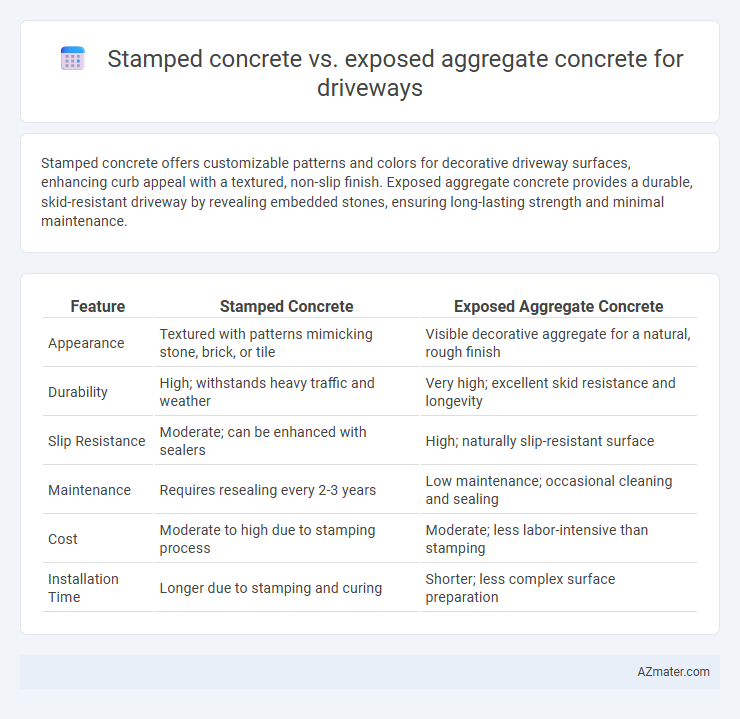Stamped concrete offers customizable patterns and colors for decorative driveway surfaces, enhancing curb appeal with a textured, non-slip finish. Exposed aggregate concrete provides a durable, skid-resistant driveway by revealing embedded stones, ensuring long-lasting strength and minimal maintenance.
Table of Comparison
| Feature | Stamped Concrete | Exposed Aggregate Concrete |
|---|---|---|
| Appearance | Textured with patterns mimicking stone, brick, or tile | Visible decorative aggregate for a natural, rough finish |
| Durability | High; withstands heavy traffic and weather | Very high; excellent skid resistance and longevity |
| Slip Resistance | Moderate; can be enhanced with sealers | High; naturally slip-resistant surface |
| Maintenance | Requires resealing every 2-3 years | Low maintenance; occasional cleaning and sealing |
| Cost | Moderate to high due to stamping process | Moderate; less labor-intensive than stamping |
| Installation Time | Longer due to stamping and curing | Shorter; less complex surface preparation |
Introduction to Stamped Concrete and Exposed Aggregate Driveways
Stamped concrete driveways are created by imprinting patterns and textures onto wet concrete, mimicking the appearance of stone, brick, or tile, enhancing curb appeal with customizable designs and colors. Exposed aggregate driveways showcase the natural beauty of stones and pebbles embedded on the surface, offering a slip-resistant and durable finish ideal for high-traffic areas. Both options provide unique aesthetic and functional benefits, with stamped concrete emphasizing decorative versatility and exposed aggregate highlighting natural texture and longevity.
Visual Appeal: Comparing Aesthetic Options
Stamped concrete offers a wide range of design patterns and colors that mimic natural stone, brick, or tile, providing a customizable, high-end appearance for driveways. Exposed aggregate concrete highlights the natural texture and color of the embedded stones, creating a rustic and slip-resistant surface with unique visual interest. Both options enhance curb appeal, but stamped concrete emphasizes detailed ornamentation while exposed aggregate showcases organic stone beauty.
Surface Texture and Slip Resistance
Stamped concrete offers a smooth surface texture that mimics natural stone or brick, creating an aesthetically pleasing driveway but often requires sealers to enhance slip resistance. Exposed aggregate concrete features a rough, coarse texture with embedded stones providing superior slip resistance, making it safer for wet conditions. For driveways prioritizing traction and durability, exposed aggregate is typically preferred due to its naturally abrasive surface.
Installation Process and Timeline
Stamped concrete installation involves pouring a fresh concrete slab, followed by applying color hardeners, release agents, and then pressing large rubber stamps to create patterns and textures, typically requiring 2-3 days to complete and cure. Exposed aggregate concrete installation requires pouring concrete mixed with coarse aggregate, then using surface retarders or washing techniques to expose the decorative stones, which usually takes 3-4 days including curing time. Both methods demand skilled labor for precise application, but stamped concrete often requires extra steps for pattern alignment, making its timeline slightly quicker than the more involved surface exposure process of exposed aggregate.
Durability and Longevity Considerations
Stamped concrete offers a durable surface with resistance to cracking and wear, provided it is properly sealed and maintained, making it suitable for high-traffic driveways. Exposed aggregate concrete features enhanced slip resistance and superior durability due to the textured surface, which also withstands harsh weather conditions and heavy loads effectively. Both options provide long-lasting performance, but exposed aggregate typically requires less frequent maintenance to preserve its integrity over time.
Maintenance Requirements and Upkeep
Stamped concrete driveways require regular sealing every 2 to 3 years to maintain color vibrancy and protect against cracking, while exposed aggregate concrete demands less frequent sealing due to its naturally textured surface. Cleaning stamped concrete involves gentle washing to avoid surface damage, whereas exposed aggregate can tolerate more robust cleaning methods without compromising its durability. Both types benefit from prompt repair of cracks to extend lifespan, but exposed aggregate's toughness generally results in lower overall maintenance costs over time.
Cost Comparison: Initial and Long-Term Expenses
Stamped concrete typically has a higher initial cost, ranging from $8 to $18 per square foot due to the detailed stamping and coloring process, while exposed aggregate concrete costs about $6 to $10 per square foot because of its simpler installation. Long-term expenses for stamped concrete can increase due to the need for frequent sealing and repairs to maintain its decorative finish, whereas exposed aggregate concrete generally requires less maintenance and offers higher durability against wear and weather. Homeowners seeking cost efficiency should weigh the upfront investment of stamped concrete against the lower long-term maintenance costs of exposed aggregate.
Climate Suitability and Weather Resistance
Stamped concrete and exposed aggregate concrete each offer unique advantages for driveways in different climates. Stamped concrete performs well in mild to moderate climates, providing a decorative surface that can be sealed for added protection against moisture and UV damage. Exposed aggregate concrete excels in extreme weather conditions, offering superior slip resistance and durability in freeze-thaw cycles due to its textured surface and robust composition.
Customization and Design Flexibility
Stamped concrete offers extensive customization with a wide range of patterns, colors, and textures that can mimic natural stone, brick, or wood, providing high design flexibility for unique driveway aesthetics. Exposed aggregate concrete emphasizes natural stone finishes by exposing decorative aggregate, allowing limited color variation but delivering a textured, slip-resistant surface ideal for modern or rustic designs. Both options cater to personalized driveway styles, but stamped concrete excels in detailed and varied design possibilities, while exposed aggregate highlights natural material beauty and durability.
Choosing the Right Finish for Your Driveway
Stamped concrete offers a variety of patterns and colors that mimic natural stone, providing a sophisticated and customizable driveway finish ideal for enhancing curb appeal. Exposed aggregate concrete features a durable, slip-resistant surface with visible aggregate textures, making it a practical choice for driveways requiring enhanced traction and low maintenance. Selecting between these finishes depends on prioritizing aesthetic appeal with intricate designs or emphasizing durability and safety in high-traffic driveway areas.

Infographic: Stamped concrete vs Exposed aggregate concrete for Driveway
 azmater.com
azmater.com